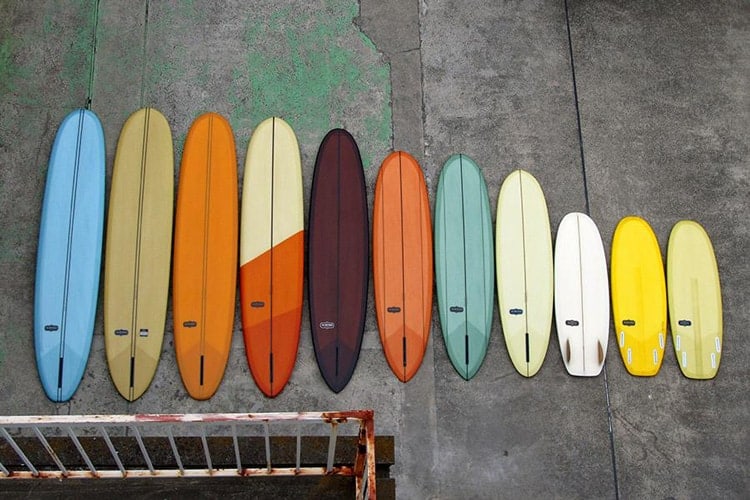
All hail the surfboard, AKA the coolest wave riding toy in the Universe. To many ocean-loving water pagans, a surfboard is the ultimate conduit of good times and fun. Surfing gives us unforgettable memories and amazing experiences that give meaning to the saying, “only a surfer knows the feeling.”
At the dawn of surfing, there weren’t a lot of options in the surfboard department. It was either a huge tall heavy piece of wood or a different species of tree for that huge tall heavy piece of wood. Well hallelujah for technology because nowadays surfboards come in all shapes, sizes, and materials.
Modern surfboards have been influenced by nearly a century of surfboard design and we now have dozens of different shapes, styles, and categories. We could write a book on surfboard shapes but for now, we’ve put together a somewhat comprehensive yet abbreviated guide to surfboard shapes.
From the longboard to fish to the bonzer and everything in between, here’s a little slice of surfboard history and the lowdown on different surfboard shapes.

The Surfboard – A Brief History
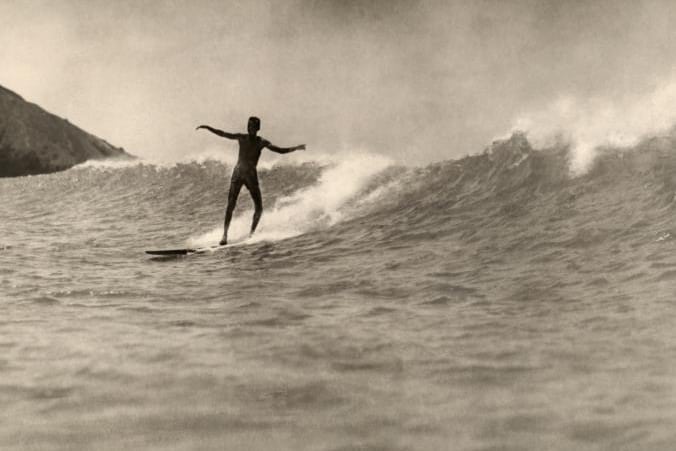
The first surfboard documented in history was in ancient Hawaii by English explorer Captain James Cook. According to journal entries dating back to 1778, Captain Cook witnessed the Polynesians riding large wooden planks on the faces of waves.
These wooden surfboards were 12-25 feet long, finless, and carved from single log Koa trees and other types of wood. Depending on the length of the plank, a surfboard in this era could easily weigh 150-200 pounds. Imagine lugging that log to the beach!
Through the 1800s and early 1900s, traditional solid wood surfboards were the only boards that existed. Surfing wasn’t even introduced to California until 1885 when a few Hawaiian royals surfed Santa Cruz for the first time. Surfing didn’t catch on in Cali until the early 1900s.
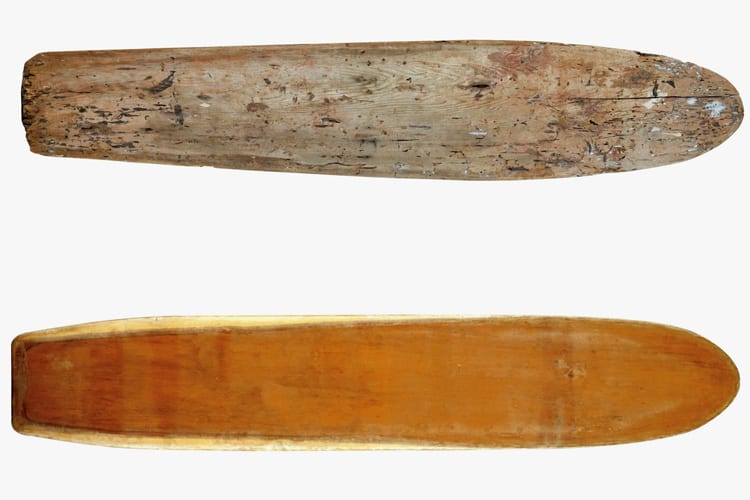
Tom Blake, an American athlete, author, and inventor created the first hollow wooden surfboard in 1926. In an effort to make surfboards lighter and more manageable, Tom drilled hundreds of small holes into a 15 feet long, 19 inches wide, and 4 inches thick solid wood surfboard. He finished the board by covering it with an outer layer of two super thin pieces of wood to keep water out of the holes.
By 1930, the hollow surfboard started to get quite popular and became the first surfboard ever to be mass-produced. At this time, surfboards were still very long commonly in the 10-15 foot range. In the mid-1930s, Tom was also credited with inventing the first surfboard fin (aka, “skeg”).
On the mainland (California and beyond), back in the early surfboard shaping days, boards were mostly made out of redwood. Redwood is strong and durable and made for a great material, but it is also very heavy. So in the 1930s, board makers started to integrate the use of balsa wood (which was much lighter) for the core. Since the materials were difficult to import from South America and redwood is much more durable than balsa, redwood remained the wood of choice for the outer shell.
During this period, surfboards got significantly lighter going from about 80-100 pounds down to 40-50 pounds which made them easier to control and drastically changed the landscape for what can be done on a wave.
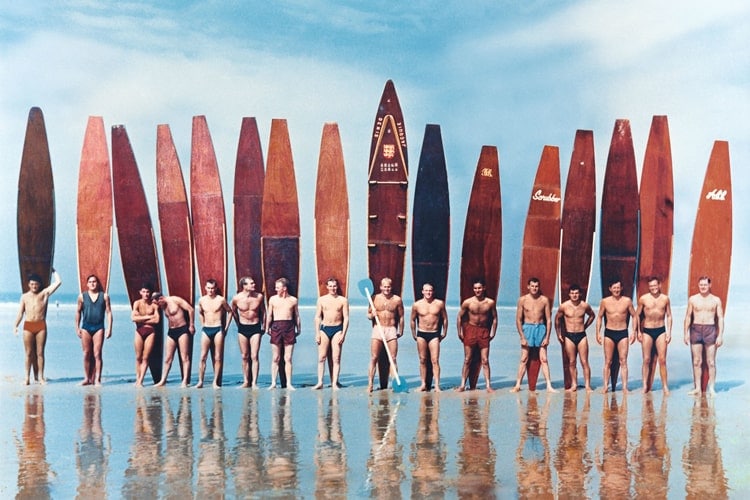
In the 1940s various surfboard shapers were experimenting with different materials and combinations of fiberglass and wood, and entirely wooden surfboards started to phase out. By the 50s, wood boards were of the past and polyurethane (foam or PU) surfboards were the new norm and the wave of the future. This was another huge milestone for surfboards getting lighter.
Fast forward until today, and modern surfboards are a fraction of weight and come in all types of shapes, sizes, and materials. While polyurethane and epoxy surfboards are the norms, wooden surfboards are coming back and all sorts of alternative materials are being used to make surfboards.
Surfboard design is a fascinating art, and it’s a downright blast to experiment with riding different types of boards. With more surfboard shapes, creativity, new technology, and surf brands than ever before, it’s an awesome time to be a surfer.
SURFBOARD SHAPES
Soft Top Surfboard (AKA Foamie)
Foam surfboards (commonly referred to as ‘foamies’) come in all shapes and sizes. You can find soft top fish, funboards, longboards, hybrids and more. Good luck finding a gun, although I’ve heard that Wave Storms go great as a step up in double overhead Pipeline. Just ask J.O.B. (In case you don’t know, I’m kidding… I’m kidding. Don’t try that).
Foam longboards are really the perfect beginner surfboards because they’re super user-friendly. They catch waves easily, are very stable, and they won’t bang you up so much while you’re learning the ropes.
However, foamies are also just super fun surfboards for surfers of any level. More advanced surfers will have a blast messing around in dumpy beach break barrels and all sorts of conditions. Check out our Soft Top Surfboard Guide for some of the best foam boards on the market.
Soft Top Surfboard Lowdown
SURF ABILITY: Absolute Beginner to Pro
BENEFITS:
- Very user friendly
- Usually plenty of volume so they paddle great
- Soft top construction is more forgiving when wiping out
- Most don’t require any wax
DRAWBACKS:
- Less glide, a bit slower than regular surfboards up and riding
- Less responsive than regular surfboards
IDEAL CONDITIONS:
- 1-4 ft range (knee to shoulder high-ish)
- Mellow rollers to dumpy beach breaks
- Points, reefs, and beach breaks
Longboard Surfboard
Longboards typically run from about 9 to 12 feet in length with a width of around 20 to 24 inches. One of the most prominent characteristics of the longboard surfboard is its full and round nose. These long and wide surfboards make for easy paddling and are the board of choice when it comes to learning how to surf.
Although basic longboards make for great beginner surfboards, they have a cult following of intermediate to pro-level surfers who would prefer surfing a longboard over a shortboard any day of the week.
Longboards come in a variety of designs from more performance shapes that cater to maneuverability and versatility to specialty boards like noseriders that cater to, you guessed it, noseriding. Longboards are also commonly referred to as a ‘log’ or ‘malibu’ surfboard. Check out our roundup of longboard surfboards for some inspiration for your next log.
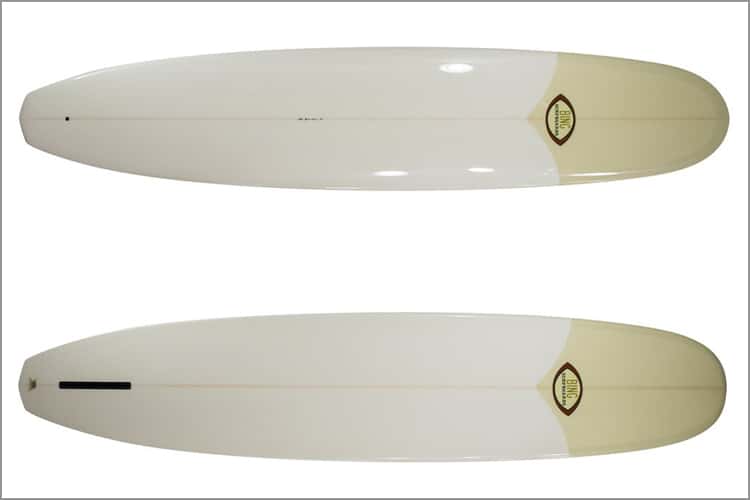
Longboard Lowdown
SURF ABILITY: Absolute Beginner to Pro
BENEFITS:
- Easy to catch waves
- Easy to paddle
- Very stable
- You can still surf on the smallest of days
DRAWBACKS:
- Big and clunky, more effort to lug around
- Can’t duck dive when the surf is bigger
- Harder to maneuver (unless you’re pretty experienced)
IDEAL CONDITIONS:
- 1-4 ft range (knee to shoulder high, for most people)
- Slower, easy breaking, crumbly waves
- Lined up points or reefs with a channel
Mini Mal Surfboard or Mini Longboard
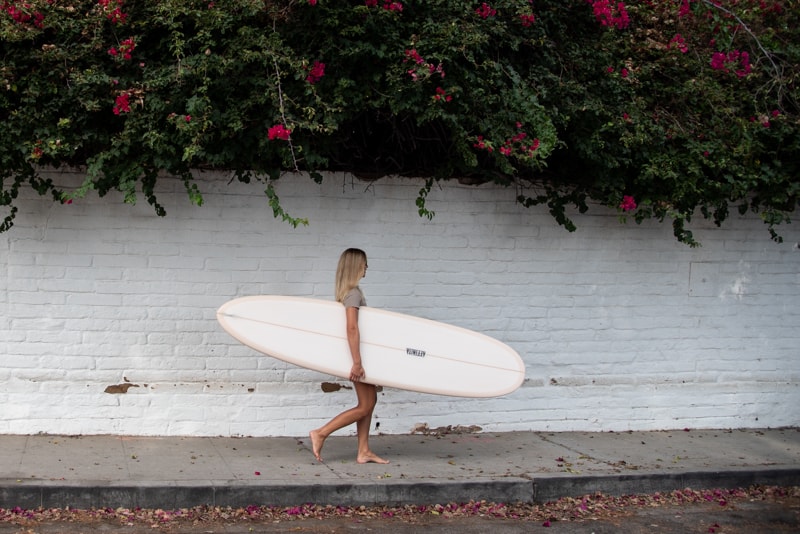
Mini mal is short for mini-malibu, and a ‘malibu’ is the name used to describe a certain type of classic California point break type longboard. So mini mal is the same thing as a mini longboard. Mini longboards have all the same characteristics as their larger counterparts but are scaled down to roughly the 7’0” to 8’10” range.
A mini mal is an awesome surfboard to have in your quiver because they bridge the gap between a longboard and a shortboard. They paddle great and are very versatile surfboards. Depending on your skills you can still walk the board, play around with cheater fives and nose-rides, and turn the surfboard a lot easier than your typical longboard.
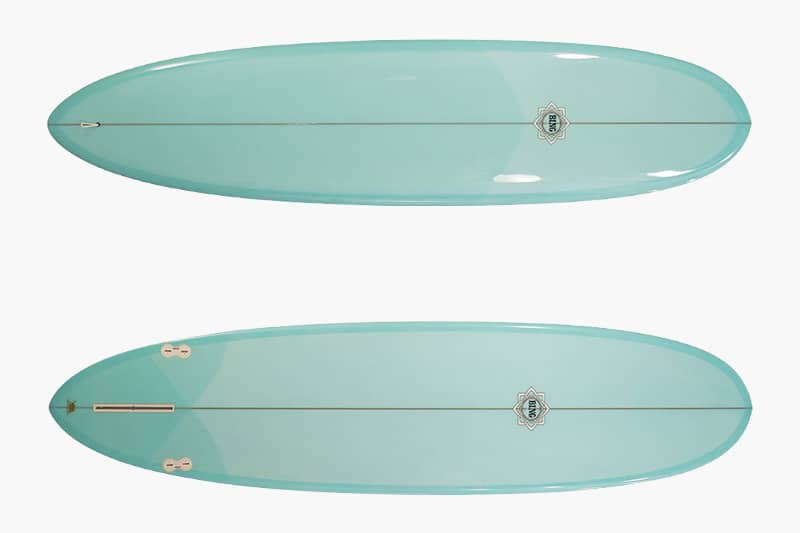
Mini Longboard Lowdown
SURF ABILITY: Beginner to Pro
BENEFITS:
- Great paddle ability
- Easier to catch waves
- Good stability
- Typically more maneuverable than a longboard
DRAWBACKS:
- Difficult or impossible to duck dive in bigger surf
- Doesn’t catch waves as easy as a longboard
IDEAL CONDITIONS:
- 2-5 ft range (knee to head high-ish)
- Slower, softer waves
- Lined up points or reefs with a channel
Funboard Surfboard
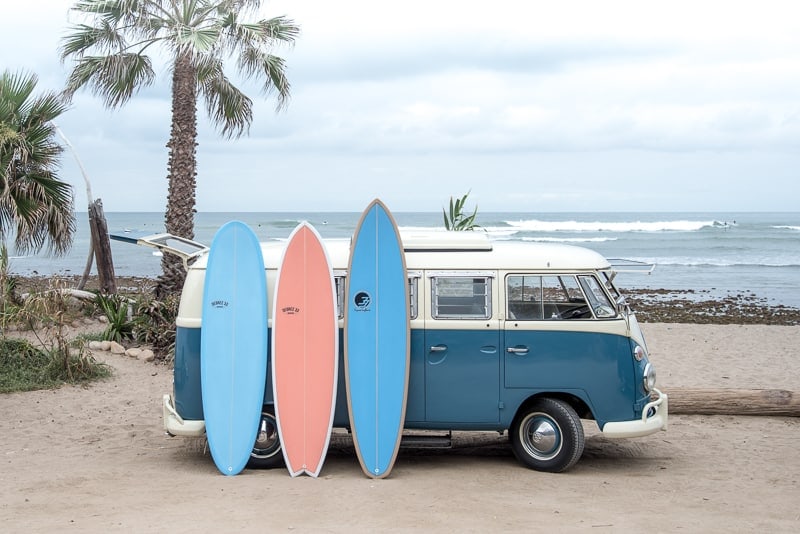
The funboard category of surfboards is very broad and can include a variety of other shapes and categories such as mini longboards or mini mals, oversized fish surfboards, egg shape surfboards, perhaps some mid-lengths, and hybrids.
But for the sake of giving the funboard a basic description, when most people refer to the category, they are talking about a board that is roughly in the 7’ to 8’ range with a wider outline, plenty of volume (buoyancy), and something that is super user-friendly.
Funboards are the perfect transitional surfboard if you’re just learning to surf and wanting to work your way down from a longboard to a shortboard. Or, if you’re around and under 120 lbs a 7 to 8 foot funboard could be a great starting point.

Funboard Lowdown
SURF ABILITY: Beginner to Pro
BENEFITS:
- Paddles well – easier to catch waves than a hybrid or groveler
- Wider outline makes for good stability
- More maneuverable than a longboard
- Works in a variety of conditions
- Easy to handle
DRAWBACKS:
- A lot of foam so duck diving is not likely an option
- Doesn’t catch waves as easily as a mini mal or longboard
- Doesn’t turn as easily as a groveler or hybrid
IDEAL CONDITIONS:
- 2-5 ft range (knee to head high-ish)
- Works in a variety of waves but cruisey mellow waves are ideal
- Points, reefs, beachies, all good. Having a channel is a plus
Mid-Length Surfboard
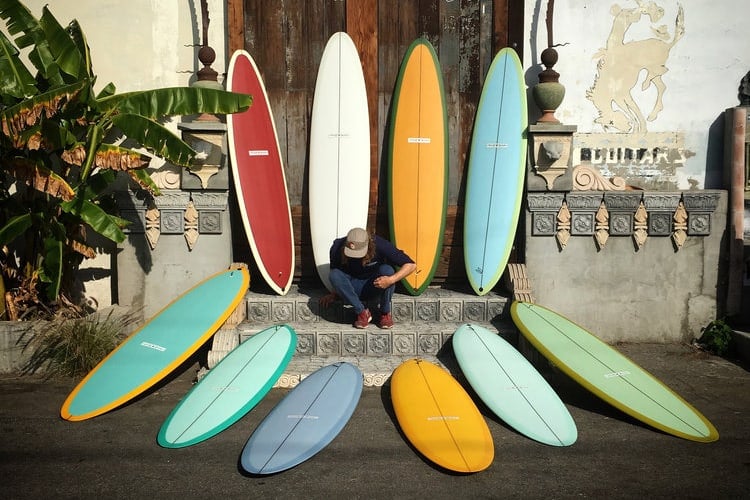
A mid-length surfboard will typically run in the 6’8” to 8’8” range, plus or minus a few inches. Mid-lengths often come in the shape of an egg, a mini longboard, and various 70s inspired retro shapes, making it easy for them to overlap with some of the other categories already mentioned like funboards and mini-mals. It just depends who you’re talking to. Mid-lengths are typically great boards for a wide variety of conditions from knee high mush to good overhead surf.
The fin set up is one key characteristic of the mid-length surfboard. Mid-length surfboards typically come as a single fin or 2+1 (single fin with 2 side bites), as opposed to a standard tri-fin or quad set up found on many funboards.
Another distinctive quality of modern-day mid-lengths are the bottom contours and rails on the surfboard, but let’s save those details for another article because it’s a lot to cover.
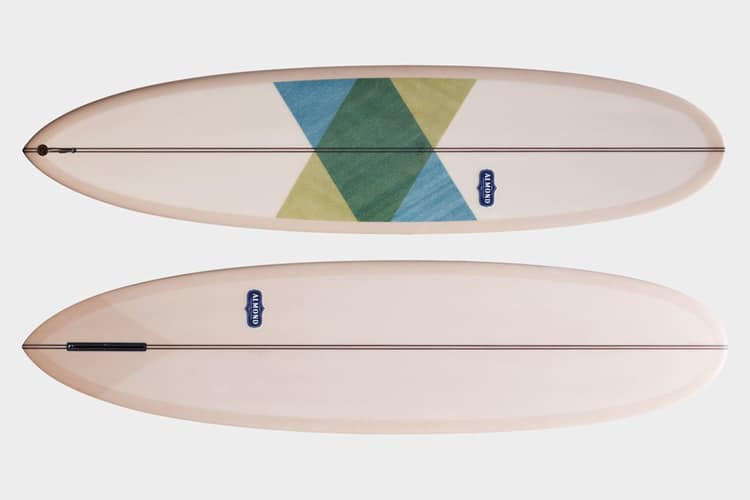
Mid-Length Lowdown
SURF ABILITY: Beginner to Pro
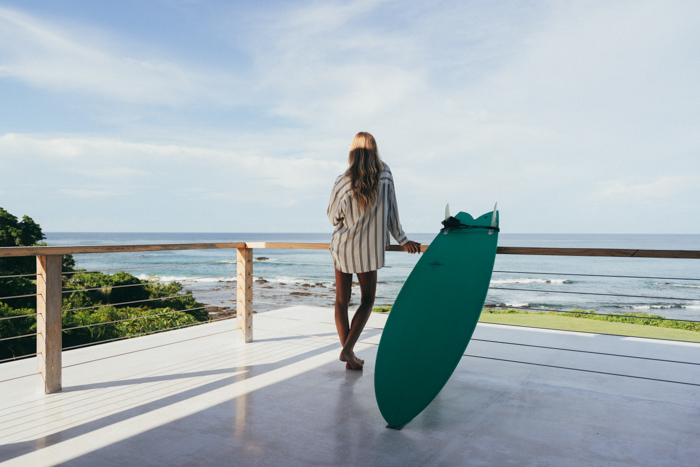
Epic surf trips made easy.
Explore luxury done-for-you surf vacations with Lush Palm Private Retreats.
BENEFITS:
- Plenty of foam, easy to catch waves on smaller days
- More maneuverable than a mini-longboard
- Good way to bridge the gap between longboard and groveler
- Amazing glide and feel for the refined surfer
DRAWBACKS:
- Duck diving not an option
- Doesn’t catch waves as easy as a full longboard
IDEAL CONDITIONS:
- 2-4 ft range (knee to head high-ish)
- Works in a wide variety of waves
- Cruisey points, reefs, or beach breaks are ideal
Shortboard Surfboard, AKA ‘Thruster’
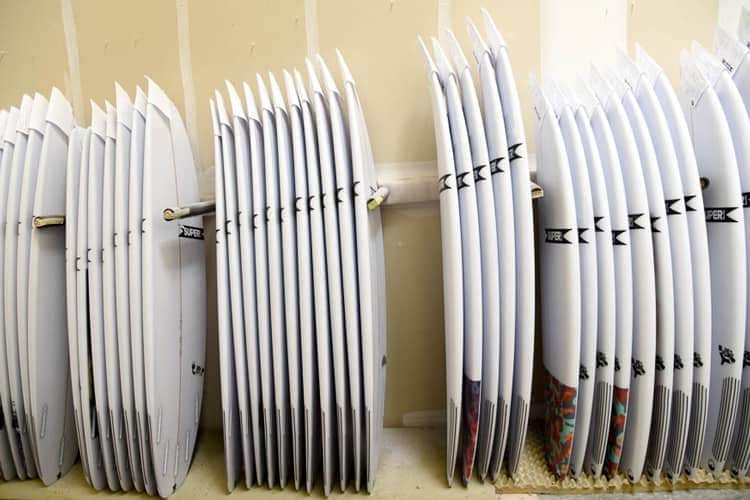
The shortboard surfboard is the most common board you’ll see around the world today. Shortboards typically range from about 5’5” to 6’5” in length and 17” to 19” in width (depending on the surfer’s height) and have a pointy nose and somewhat narrow tail.
Shortboards are the surfboards of choice for aggressive, high-performance style surfing, so they are best suited for the advanced surfer and are what the pros and competitive surfers ride in high-performance surf contests. You can push shortboards the hardest and surf them in the most critical of waves. Your typical performance shortboard is not a good option for learning how to surf or for surfing in small, mushy, or average conditions.
While the term ‘thruster’ is specifically reserved for a shortboard surfboard with 3 fins (2 side fins and a center fin), many shortboards these days come with 5-fin boxes which give you the option to set up your surfboard as a thruster (with 3 fins) or a quad (with 4 fins). Check out our Shortboard Buyer’s Guide for an in-depth look at shortboard design and some of the best-selling shortboards on the market.
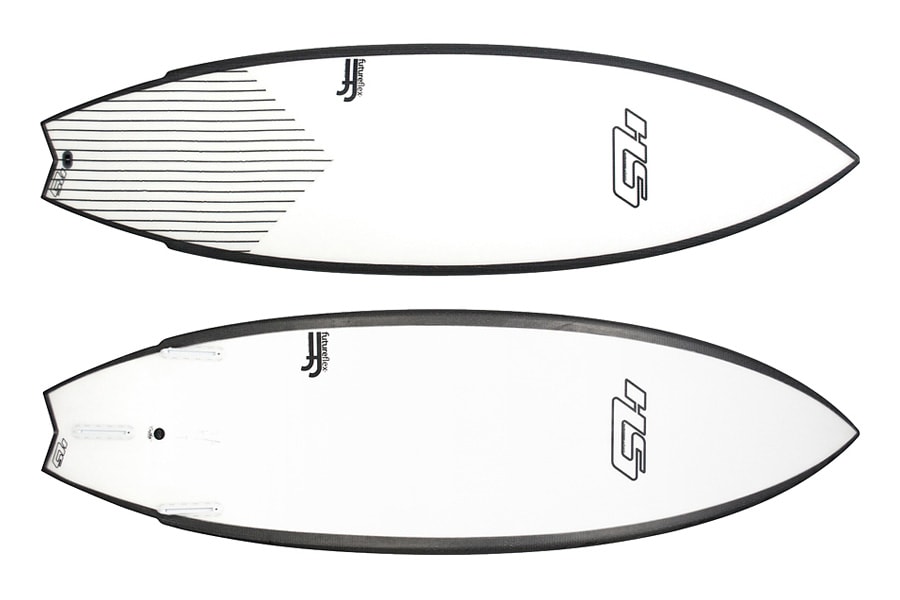
Shortboard Lowdown
SURF ABILITY: Intermediate to Pro
BENEFITS:
- Tailored to high-performance surfing
- Lots of drive and ability to generate speed
- Very maneuverable and responsive
- Good for late drops and critical waves
- You can duck dive larger waves with ease
DRAWBACKS:
- Less foam = harder to paddle
- Requires positioning and timing knowledge to catch waves
- Hard to surf on smaller, mushier days
IDEAL CONDITIONS:
- 3-8 ft range (chest high to overhead)
- Punchy, more critical, high performance waves and good surf
- Points, reefs, beach breaks, you name it!
Groveler or Small Wave Surfboard
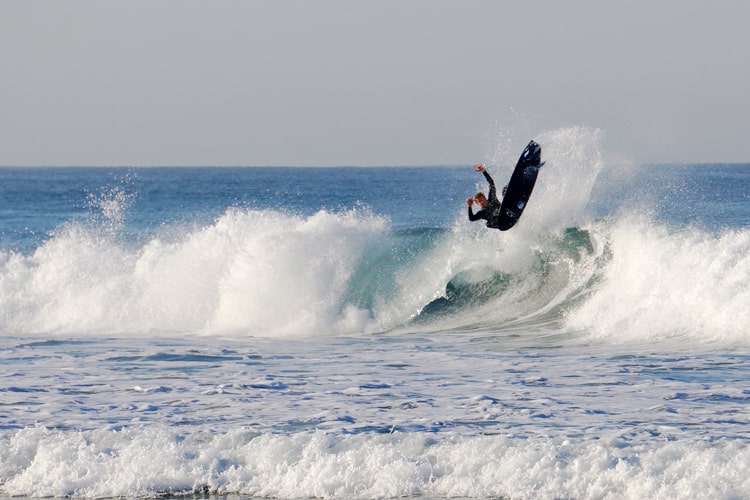
A groveler surfboard is a smaller, wider, thicker, flatter, and fuller shortboard template. Grovelers are essentially shortboards that are specifically built to perform in small to average surf.
Grovelers come in a wide variety of shapes and sizes–from designs that might be hard to tell the difference from an ordinary shortboard, to full-on fat, round, and stumpy looking things that will have you wondering how to describe it.
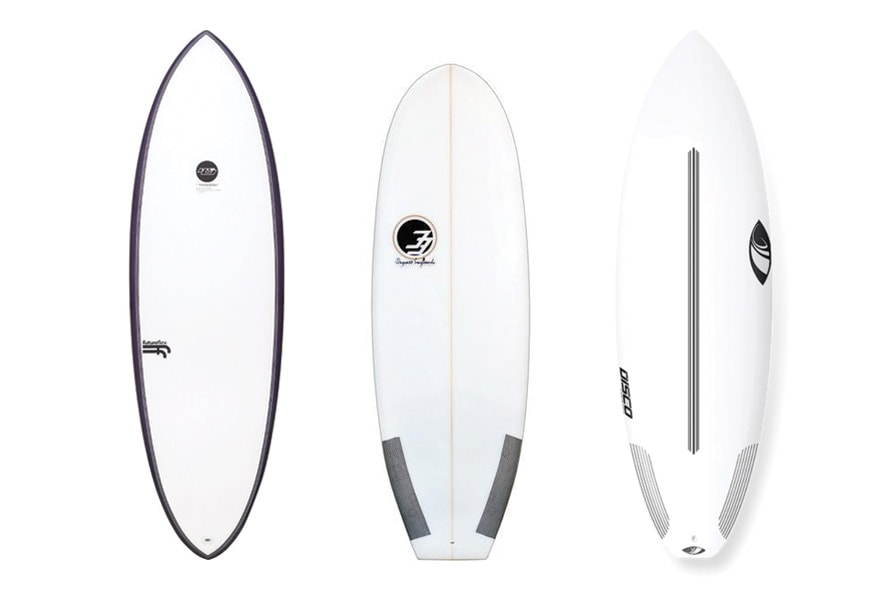
Groveler Lowdown
SURF ABILITY: Advanced Beginner to Pro
BENEFITS:
- Gives you the ability to ride a shortboard in smaller, mushier waves
- Highly maneuverable, yet more stable than a shortboard
- Shouldn’t be a problem duck diving larger waves
- Paddles and catches waves easier than shortboard
DRAWBACKS:
- Not ideal for more critical waves and drops
- Paddles better than a shortboard but not as easy as a funboard
IDEAL CONDITIONS:
- 2-5 ft range (waist to head high)
- Works in a wide variety of conditions
- Points, reefs, beach breaks, and more
Fish Surfboard
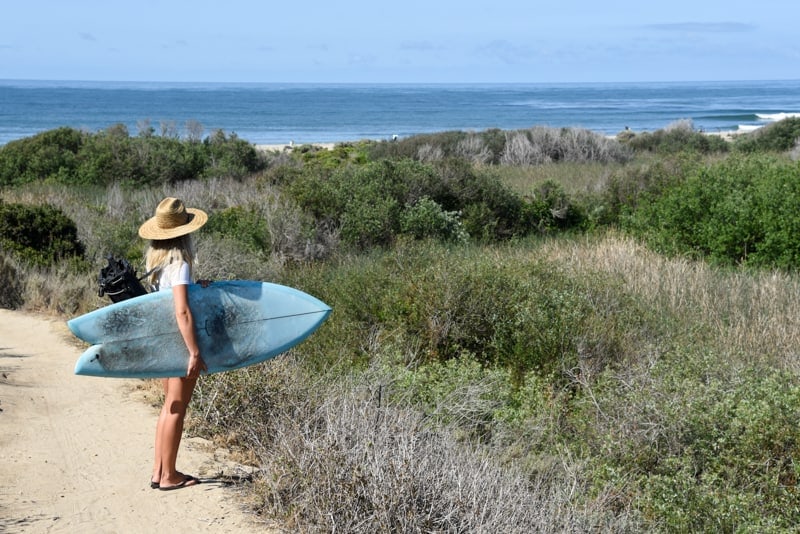
Fish surfboards are all about speed, style, and flow, and can be a super fun everyday surfboard for many surfers. They are extremely versatile and can be used in anything from knee high mush to hollow overhead barrels. Fish surfboards are defined by their short wide outlines, flat rocker, and fishy swallow tail shapes.
Your typical fish surfboard ranges from about 5’2” to 6’2” in length and 19” to 23” in width, however, there are now plenty of super fish and mega fish shapes easily going into the 7’, 8’, and 9’+ range. Many of these larger fish shapes can also be considered funboards and hybrids. Fish most commonly come in quad fin or twin fin setups. Learn more about fish in this Fish Surfboard Guide.
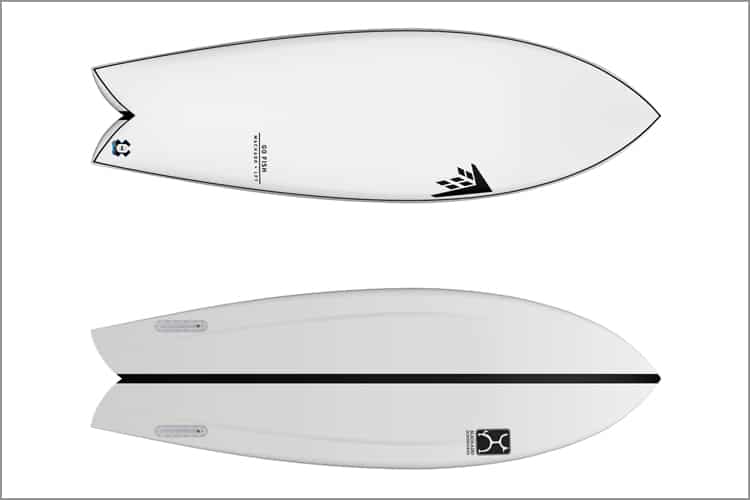
Fish Surfboard Lowdown
SURF ABILITY: Advanced Beginner to Pro
BENEFITS:
- Gives you the ability to surf a smaller board on average days
- Fast down the line and through mushy flat sections
- Easy to duck dive (if not surfing an oversized fish)
- Flat rocker makes for easier paddling and increased wave count
- Enhanced fun factor in average surf
DRAWBACKS:
- Can be difficult to surf on steeper waves (for avg. surfers)
- Loose and squirrely (could also be considered a benefit)
- Trying to compete for waves with longboarders on small days
IDEAL CONDITIONS:
- 2-5 ft range (waist to head high)
- Works in a wide variety of conditions
- Points, reefs, beach breaks, and more
Hybrid Surfboard

A hybrid surfboard is a blend of two or more different types of surfboards. So in many cases a hybrid can also be used to describe a groveler or a funboard.
A very common and clear example of this is if you were to blend a fish with a standard shortboard. What would you come out with? A pretty cool performance groveler like the Superbrand Tazer shown above. So there’s definitely a lot of overlap in the hybrid category.
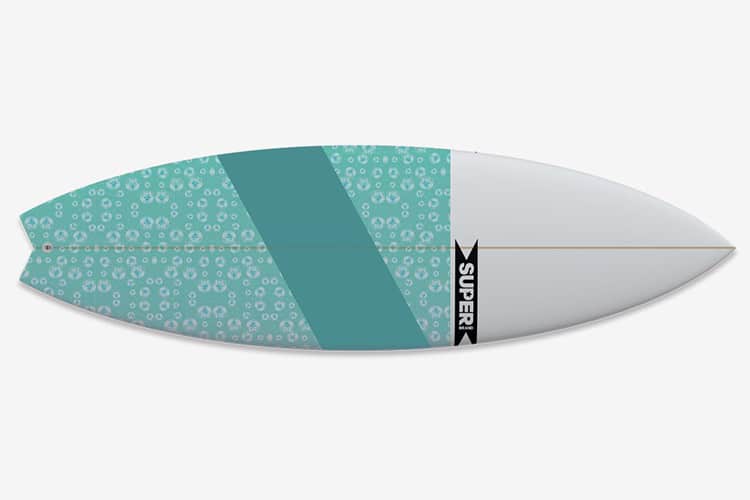
Hybrid Surfboard Lowdown
SURF ABILITY: Advanced Beginner to Pro
BENEFITS:
- Ability to ride a shortboard in smaller, mushier waves
- Highly maneuverable but more stable than a shortboard
- No problem duck diving larger waves for experienced surfers
- Paddles and catches waves easier than shortboard
DRAWBACKS:
- Paddles better than a shortboard but not as good as a funboard
IDEAL CONDITIONS:
- 2-5 ft range (waist to head high)
- Works in a wide variety of conditions
- Points, reefs, beach breaks, and more
Mini Simmons Surfboard
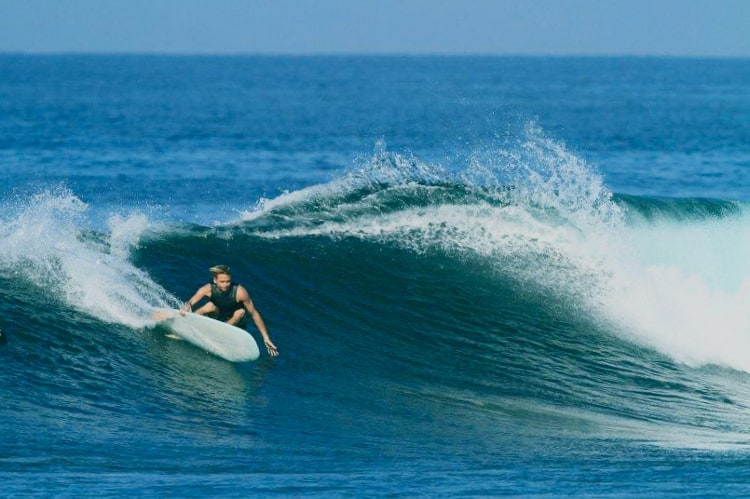
A mini simmons more or less looks like a longboard cut in half. With a short and wide outline and a full longboard shaped nose, the mini simmons surfboard is an unmistakable surfboard shape. They usually run from about 4’10” to 5’10” in length and 21” to 23” in width, with a length of 5’2” to 5’6” being the sweet spot for most surfers.
The ‘planing hull’ or mini simmons surfboard is an engineering masterpiece invented by Bob Simmons (aka the father of the modern surfboard) in the 1940s. It is insanely fast down the line and flies through flat sections with ease making it a great option on mushy days, although it can hold its own in hollow surf too. It has a loose feel and often comes as twin fin or quad for added control and maneuverability.
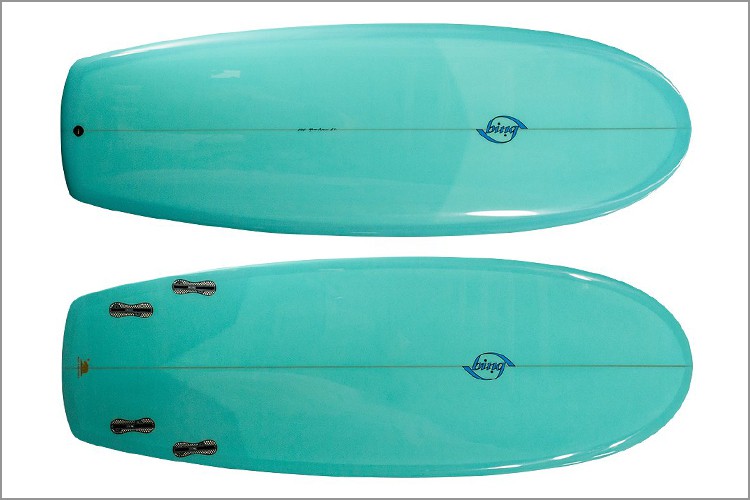
Mini Simmons Lowdown
SURF ABILITY: Intermediate to Pro
BENEFITS:
- Super fast down the line
- Paddles well
- Flies through flat sections in mushy weak waves
- Great option for diehard shortboarders to compete with longboarders
- Good option for diehard longboarders looking to experiment with shortboards
- Loose, skatey, and super fun
DRAWBACKS:
- Not a good choice for beginners because fast and loose like a bar of soap
- Not as stable and user friendly as a groveler
- Can still be hard to compete with longboarders
IDEAL CONDITIONS:
- 2-4 ft range (knee to shoulder high-ish)
- Works in a variety of conditions
- Mellow reefs and points to beach breaks
Step Up / Semi-Gun Surfboard
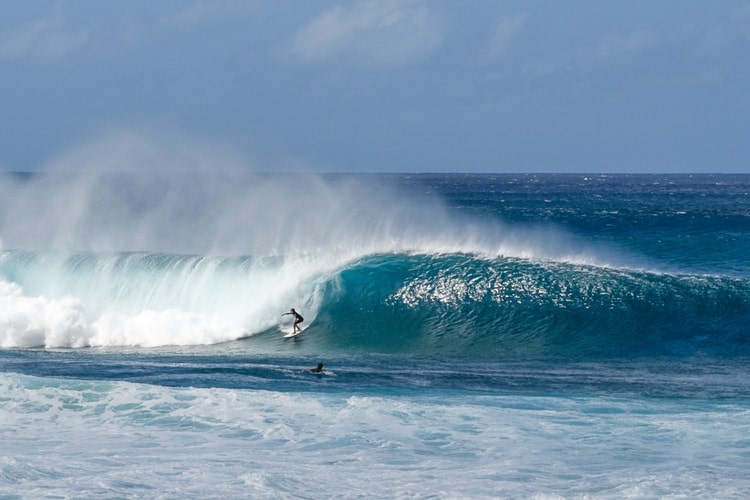
When the waves are too big for the ordinary surfer on an ordinary shortboard, that’s when step up surfboards come in handy. A step up is a stretched out version of a shortboard made for bigger waves, like a groveler is a fatter condensed version of a shortboard made for smaller waves.
Step ups often start around 6’6” and can go up to 8’ or so. But on the note of board length, it very much depends on the surfer’s height. For example, if a surfer is 5’8” tall, then a step up surfboard to that surfer would likely be around 6’2” to 6’4” whereas that same surfboard size could easily qualify as a shortboard for someone who is 6’2” tall.
However, step ups often have some defining characteristics such as more narrow outlines and pulled in tails so they can handle more critical drops and steeper faces of waves. The extra length in a step up surfboard makes it easier for a surfer to catch a larger wave that is moving at a faster velocity.
If you’re used to riding smaller surfboards you might think you’ll have a hard time turning a 6’10” or 7’ step up. But once you get a board that size on bigger waves, they turn just as easy as a smaller board in normal waves.
Step Up Lowdown
SURF ABILITY: Advanced to Pro
BENEFITS:
- Helps with critical drops and steep waves
- Paddles and catches larger waves better than a shortboard
- Highly maneuverable yet stable in large surf
DRAWBACKS:
- Hard to maneuver if the waves aren’t as big as you thought
- Difficult to impossible to duck dive due to extra length and volume
- Might make you think you can handle bigger waves than you should be surfing
IDEAL CONDITIONS:
- 8-15 ft range (head and a half to double overhead)
- More performance-oriented larger waves
Bonzer Surfboard
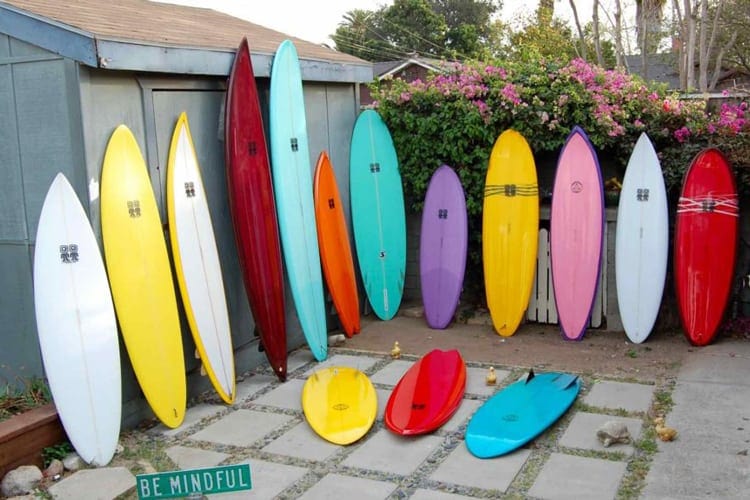
The bonzer surfboard is more of a specific fin set up than a certain surfboard outline. You can get grovelers, retro shapes, midlength boards, and more as a bonzer. The 3- and 5- fin setups have a single larger center fin with smaller more shallow glassed in side fins positioned at specific angles to harness the energy of the water flow as it passes under the board.
This unique fin system delivers continuous speed and momentum through maneuvers like cutbacks and bottom turns to provide excellent rail to rail transitions. Bonzer’s have a lot of history in which The Campbell brothers played a large role. You can read more about it here.
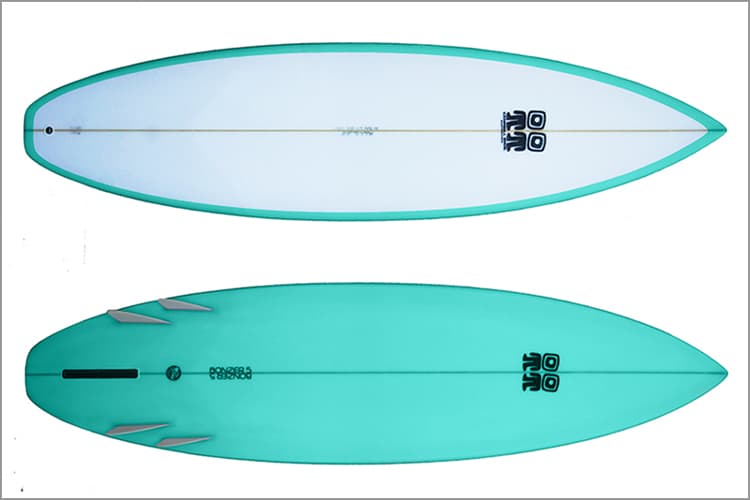
Bonzer Lowdown
SURF ABILITY: Beginner to Pro
BENEFITS:
- You can get a bonzer in a variety of shapes
- Unique design creates ideal water flow through the tail area
- Depends on the shape
DRAWBACKS:
- Depends on the shape
IDEAL CONDITIONS:
- 1-15 ft range (depends on shape)
- Points, reefs, and beach breaks
Gun Surfboard
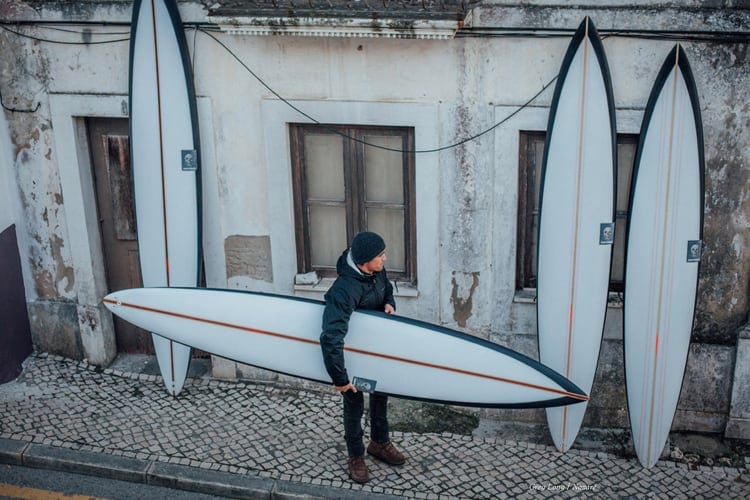
Designed for surfing extra large waves, a gun is a special type of surfboard. We’re talking waves of serious consequence that are double to quadruple overhead on up. Guns are often custom ordered with the rider and region, type of wave, or specific break in mind. The size of a gun surfboard can vary drastically from about 6’6” to 11’ in length and 18” to 22” inches wide.
Guns are generally long, pointy, thick, and narrow. The gun will have a lot more rocker or flip in the nose of the surfboard to help the surfer make more critical, steep, and late drops. The added length and thickness of guns give surfers the ability to gain more momentum when paddling into large waves, since they need to match the speed of the wave in order to have a chance at catching it.

Gun Surfboard Lowdown
SURF ABILITY: Pros and Big Wave Experts only
BENEFITS:
- Extra length and volume helps with paddle ability
- Rocker and sleek design assists with making critical drops on large waves
DRAWBACKS:
- Specialty surfboard made only for very specific kamikaze conditions
These boards are really only meant to be surfed in very specific conditions – essentially, giant waves
IDEAL CONDITIONS:
- 15-50 ft range (double overhead to skyscraper size waves)
- More performance oriented larger waves
SURFBOARD FAQs
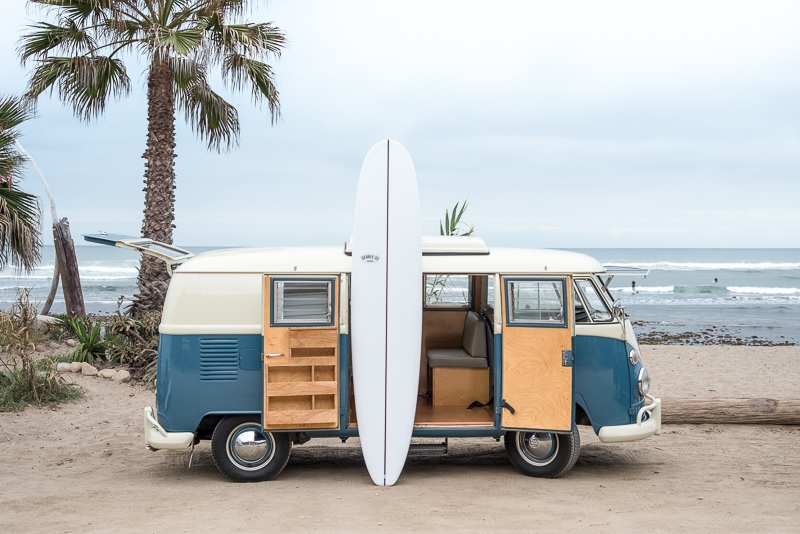
The best surfboard for beginners is definitely a longboard surfboard. With a wide stable outline and lots of buoyancy, longboards make it easier to paddle, catch waves, and balance. Learning to surf on a longboard will help you catch more waves, which will give you more experience, which will ultimately help you improve your surfing faster. Learning to surf can be slow and challenging, and choosing the right surfboard can make a huge difference. Check out this Guide to the Best Beginner Surfboards to help you find the ideal boards for the fastest surf progression.
The cost of a surfboard can vary from around $150 for a heavily used surfboard or a cheap foam surfboard, to around $1,600+ for a beautiful brand new longboard with resin tint and a premium glass job. Surfboard costs are primarily based on cost of labor, cost of materials (foam needed, fin setup, color, etc), craftsmanship, supply/demand, and overall brand positioning.
Here are typical surfboard price ranges for new surfboards:
– Longboard Surfboard Cost: $900 to $1,600
– Mini Mal Surfboard Cost: $900 to $1,400
– Shortboard Surfboard Cost: $600 to $900
– Groveler Surfboard: $600 to $900
– Hybrid Surfboard: $600 to $900
– Step up Surfboard: $600 to $900
– Fish Surfboard: $600 to $1,200
– Funboard Surfboard: $600 to $1,200
– Mid-length Surfboard: $800 to $1,200
– Mini Simmons Surfboard: $600 to $900
– Bonzer Surfboard: $600 to $900
– Gun Surfboard: $900 to $1,500
– Soft Top Surfboard Surfboard: $150 to $600
If you’re a beginner surfer, you should start by getting a longboard or mini longboard that is roughly 3 feet longer than you are tall. For most people, either 8 or 9 feet long is a good starting point. In the beginning stages of surfing, it’s all about catching as many waves as possible to get a good grasp of the fundamentals. To learn more about surfboard sizes, check out this Guide to the Best Beginner Surfboards to learn how to speed up your learning curve.



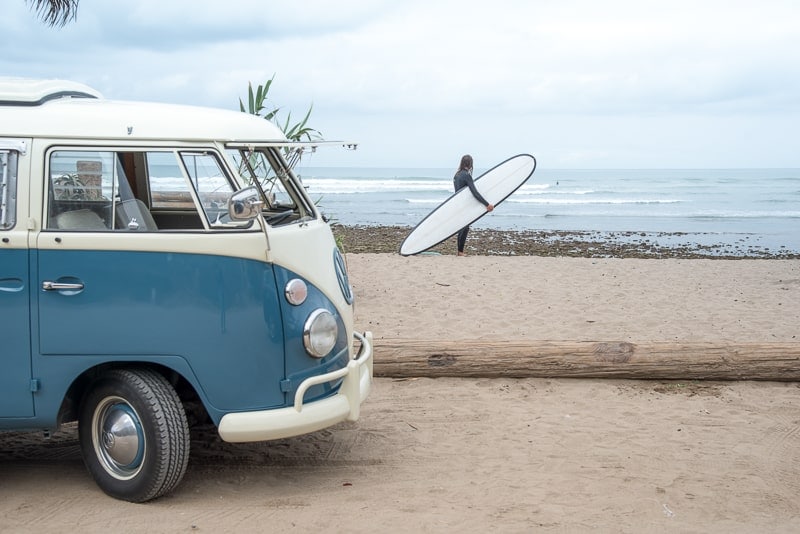
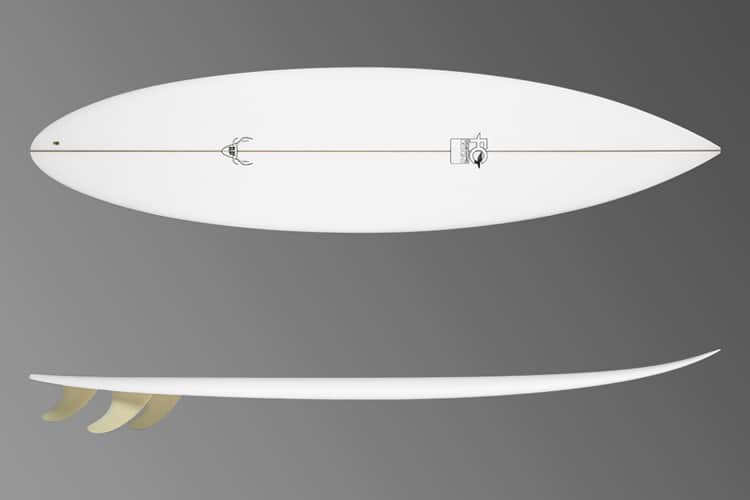
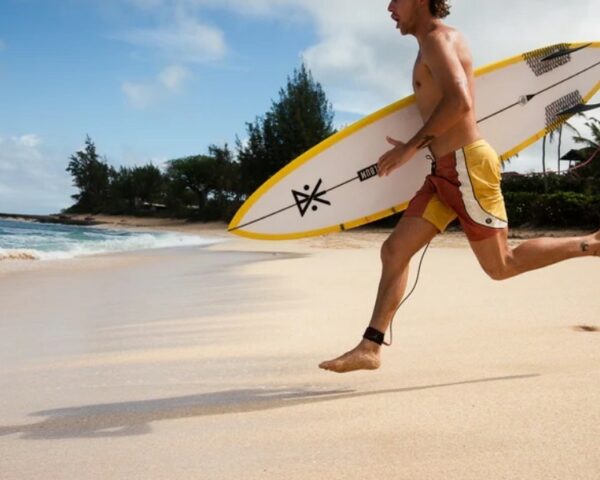

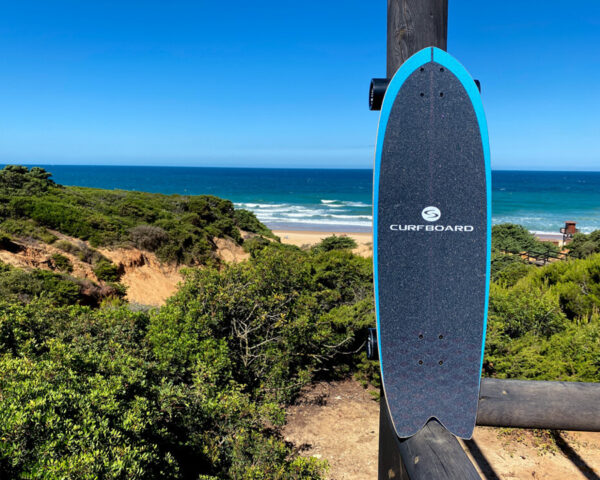

Hi there,
I am trying to find out who owns the image of the light blue surf van, [with the rattan seat and surf board located just outside the sliding door].
I am seeking permission to use this image as a background for advertising my product in E Commerce.
Please davise if you can help or want further info.
Regards
David [Gold Coast of Australia]
Hi David, thanks for getting in touch and for asking. The one from our sidebar, yeah? That’s our original photo — we’ll be in touch to discuss.
Great, informative article regarding surfboard styles and uses.
Thanks, Felicia! Happy you found it helpful. Cheers
I enjoyed your great description of boards for surfing styles .More information than a surf shop .
Thanks! Happy you found it helpful.
Great article! I have been riding a wave storm for a year now. I’m still not that great, since I wasn’t going often. When the waves are more than 3 or 4 feet and steep, I tend to nose dive and also unable to duck dive. I’m thinking of buying another board but undecided. I surf a few miles north of Santa Cruz in California. I’m 5.38 tall and 125 lbs, thank you!
Awesome, Par – happy you found it helpful. When you’re ready to level up from your Wave Storm, check out this guide to the Best Beginner Surfboards. This guide will give you more info on buying your next surfboard. Cheers!
Hello, what do you think about electrical boards? Are you familiar with them, what do you think?
Hey Chris, happy you enjoyed the article! Electrical boards are obviously very different than normal surfboards, and I suppose it goes back to what kind of experience you’re looking for and why you’re considering an electrical board (whether you live inland or in an area without many waves, etc).
I definitely wouldn’t recommend taking an electrical board into a lineup with other surfers. If you have an electrical board it would be best to keep your distance and find your own little peaks away from others. I’ve ridden an electrical board a couple of times in flat conditions and they are fun, but they are a completely different experience than normal surfing. I would liken them to like a motorized stand-up paddleboard, as you’re typically standing most of the time.
I have a friend who bought a really expensive motorized surfboard and it broke down ALL THE TIME and the company was very far away so it was pain to try to get it fixed, etc. Also, it broke down one time when he was far out in the ocean and literally started sinking! He was lucky that some nearby people helped him out, but he almost saw $13,000 sink to the bottom of the ocean!!! If you’re considering buying one, I would do some serious research and especially consider their warranty and return policy because I think they are prone to going kaput. Is there a specific brand you are considering?
Hello, Tara! Thanks for the comprehensive answer. Regarding your question of which brand I have stopped I looked pretty but definitely stopped on this https://awakeboards.com/, they seem reliable to me. What do you think of them I will be grateful for your opinion!
Hi Chris! My pleasure. I wish I could help more, but honestly, I don’t know the brand and I’m not familiar enough to give you guidance on motorized surfboards beyond what I previously wrote. Motorized surfboards are a pretty new category in general, so there isn’t much information out there on them. If you’re interested in this company and they look good, as I mentioned I would really make sure they have a good warranty because I think those things are privy to breaking down in general.
It depends on your reasons for wanting a motorized surfboard, but alternatively, you could always put that money toward a couple of awesome surf trips 🙂
Hi Tara,
Yep, there is a big difference in experience between the boards as described in this blog as to motorized ones (electric DFI, whatever). They are not for the purists. But now you make me curious about the board that broke down. 13K oefff. Tough on to suck it up.
Was it Jet Surf?
Let me know.
Enjoy!
Hey Nick – yep, it was Jet Surf! I see you created their website 🙂 You probably know more about motorized surfboards than most!
Thanks that was a great article! I changed from balsa boards to foam in 1961 and the first time out with foam core boards my partner and I were surprised with the sound of the whitewater hitting the board on the way out! It was so different and louder than our woodies! Does anyone else remember that? We were in Hermosa Beach, Ca. Thanks again
Thanks, glad you like the article! Wow, what an awesome memory, Bill! That was long before my time, haha, but I’d love to get the chance to take out one of those old wooden boards someday. I’m sure I’d be terrible at dealing with the extra weight and it would be a whole new experience of surfing. Good times and thanks for sharing. Cheers